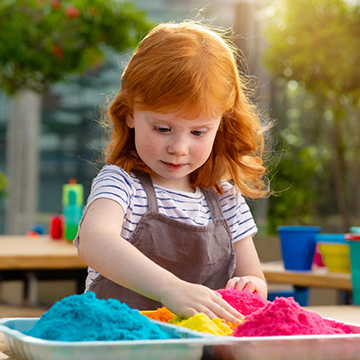Hope & Health
Articles and Updates from WVU Medicine Golisano Children's
01/1/2024 | Federico Seifarth, MD, FAAP, FACS
Kinetic Sand is a Popular Toy, but Doctors Warn of Potential Dangers
Information in this blog post was taken from case report titled “Ingestion of kinetic sand leading to intussusception and bowel obstruction in a child” published by WVU Medicine physicians Acara Turner, MD; Rita Sico, DO ; and Federico Seifarth, MD.
Kinetic sand is a type of play sand, also known as magic sand or hydrophobic sand, that is marketed as a play sand for children above the age of three-years-old.
It is comprised of sand coated with silicone oil, holding its shape when squeezed or pressed. It is described as a non-toxic, hypoallergenic, safe sand for arts and crafts and is highly appealing due to its realistic appearance and odor.
This moldable sand comes in play kits with themes that range from construction sites to food kits, like ice cream treats, and select sands are scented to complement the theme.
While parent information labels state that this product is nontoxic, the packaging displays a choking hazard due to its small parts. However, the packaging does not contain any warning regarding other potentially dangerous consequences of kinetic sand, like ingestion.

That’s what parents should look out for. A group of WVU Medicine physicians treated the first reported case of kinetic sand ingestion causing bowel obstruction. A two-year-old patient was transferred to WVU Medicine Children’s after two days of abdominal pain and other symptoms. Testing showed that she had a bowel obstruction caused by intussusception, which is a life-threatening illness that happens when a portion of the intestine folds, with one segment slipping inside another.
According to the case report, there have been many cases of dogs or other animals ingesting kinetic sand, which can lead to life-threatening bowel obstructions. However, this is the first time it’s been documented in children.
Parents are advised to supervise children when playing with the sand.
While kinetic sand is marketed as non-toxic, it can be if ingested.
Physicians are not telling parents to do away with this popular toy altogether, just be cautious about what you’re buying. It’s specifically the kinetic sand products that look like and smell like snacks and desserts that young children may ingest because they look like their favorite treats.
No parent wants playtime to end in a hospital visit, so be cautious. To read the full case report, click here.
